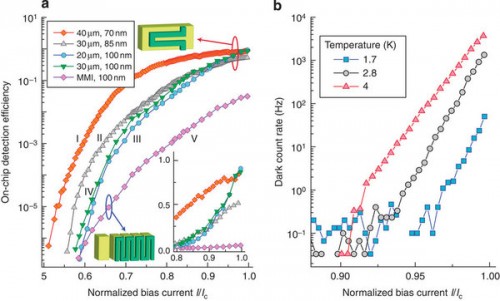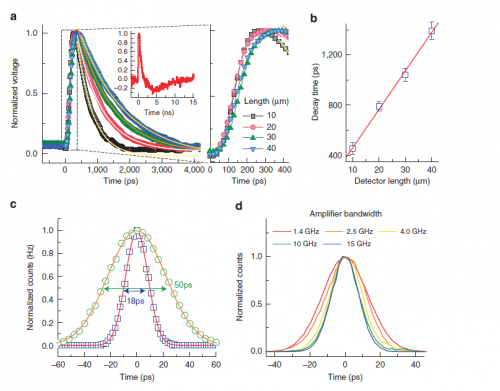
While it is often taken for granted, whether we are browsing the Web or texting friends, our daily communication depends on complex networks for the wireless exchange of information. Although communication channels have advanced over the past few decades, they are still subject to speed limitations, timing delays, and vulnerability to noise, all combined with insensitivity to some information carriers and finite photon-detection efficiency.
Researchers in the Yale Nanodevices Lab recently addressed some of these problems by embedding a single-photon detector (SPD) in a silicon framework, enabling a drastic increase of the absorption length for incoming photons. “Ultrafast, high-efficiency single-photon detectors have been among the most sought-after elements in modern quantum optics and quantum communication,” said Professor Hong Tang, the leader of the Tang Group in the Yale Nanodevices Lab.

The Hamletian rumor has it that there are more things offered by this new technology than are dreamt of in your philosophy ¬— ultra-fast and, most importantly, scalable on-chip SPDs will potentially be employed for quantum communication purposes. The development of scalable quantum computation opens a road for increasing quantum measurement precision and computational power far beyond what is attainable by traditional computers.
Research in quantum information, a theoretical and experimental scientific discipline based on the idea that information transmission depends on quantum physics effects, promises to make great strides in the improvement of communication channels. To this end, the Tang Group focused on research in silicon circuits, which proved to be a convenient infrastructure for construction of high-performance nanophotonic devices. The advantage of silicon nanophotonics stems from the fact that they use light instead of electrical signals to transfer information between computing systems. This technology has been researched for more than a decade by IBM scientists.

Despite difficulties, the researchers achieved up to 91 percent photon detection at telecom wavelengths, which was repeatable across a series of fabricated chips. The detection ability of propagating single photons, more often referred to as OCDE or on-chip detection efficiency, is a key performance parameter for chip-based quantum optical devices. The researchers also observed astonishingly low dark count, or noise, rates without major compromise of the OCDE. High temporal resolution, together with high OCDE and scalability, is a necessity for fast photon transport, which is desirable in quantum information processing. Exploiting this high temporal resolution, the researchers in Yale Nanodevices Lab succeeded in fully embedding high-speed and high-efficiency single-photon detectors on nanophotonic circuits.
Normally, quantum photonics researchers face numerous challenges, including imperfect modal matching and low photon-absorption rates. Despite tremendous effort to increase the absorption length for incoming photons, there are still coupling losses, which are highly undesirable in free-space application and can be avoided only by making the OCDE as close to 100% as possible. The cost of further increasing detection efficiency is somewhat lower detection speed, which is the reason why quantum cryptography is still relatively inefficient. However, the SPDs constructed by Yale researchers are perfectly suitable for use in integrated photonic circuits.

The detectors are fully implanted in silicon circuits and provide an ultrashort timing jitter of 18 picoseconds. “This work, to us, is a giant step forward for making scalable quantum circuits. Our detector can detect the faintest signal that other detectors would not detect. It is among the world’s most sensitive devices,” confirmed Tang. The enthusiasm in the Yale Nanodevices Lab is warranted: their successful attempt to directly embed a high-performance SPD has overcome a crucial difficulty in integrated quantum communication.
The impact of this technology goes far beyond fundamental physics. As Tang explained, “The Yale team is actively pursuing a variety of niche applications, such as remote sensing and single-photon imaging.” With further work, the breakthrough in quantum communication may advance technology in a number of fields.

